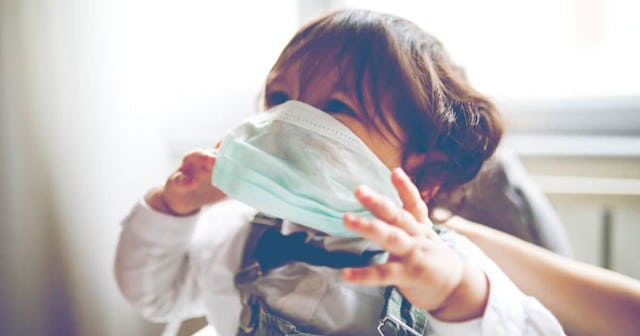You Should Never Put A Face Mask On Your Baby (Or Any Child Under Two)

At first, Americans were told that face masks were not an effective way to protect themselves against COVID-19, but just weeks later, the Centers for Disease Control and Prevention encouraged the public to wear some type of protective face covering to help block the transfer of respiratory droplets from an infected person. With this news, there came an outpouring of innovative face mask DIYs from parents. Some taught folks how to make no-sew masks with things like bandanas, old shirts, and even socks, while others dusted off the old sewing machine and got seriously crafty during quarantine. But there was one tutorial in particular that, despite its well-meaning intentions, made other parents cringe: the pacifier face mask.
According to the CDC, there are two groups of people who should be exempt from wearing cloth face mask coverings: infants who are under two, and those who have difficulty breathing or cannot remove the mask themselves. Though we’re in the middle of a pandemic, we can’t forget or dismiss the negative and dangerous outcomes that can occur when an infant’s nose or mouth is obstructed.
Infants under two have narrower airways, which could cause restricted breathing with a mask, CNN explains. As those lungs start to work harder for oxygen, they can become stressed, and the resulting factor could lead to accidental suffocation.
“Kids under two can’t remove [face masks] easily and because their airway is smaller, they don’t have as many reserves if they don’t get enough oxygen and [therefore] have a higher risk of suffocation,” Andy J. Bernstein, M.D., a physician at North Suburban Pediatrics in Chicago, tells Yahoo. “A kid under two likely couldn’t communicate if fabric was choking them. So little kids are at higher risk for problems whether it’s breathing or not being able to remove the mask.”
The actual mask itself is a choking concern, but experts are also warning parents that an excess amount of spit up or vomit could become trapped inside of a face covering and cause a child to choke as well.
So, with these risks in mind, is there anything parents can do to protect their baby from COVID-19? Though there are few options available — and even fewer for the smallest among us — yes, there are ways to keep your baby protected from COVID-19.
Since infants cannot wear masks, this highlights the importance of following the COVID-19 safety guidelines given to us by the CDC. This would include only allowing symptom-free family members around your baby after washing their hands for the recommended 20 seconds, keeping your baby as socially distanced as possible, cleaning commonly-touched surfaces regularly, and teaching younger siblings not to touch the baby’s face.
If you do need to leave the house with an infant and cannot abide by the guidelines of social distancing, physicians are instructing parents to drape a lightweight blanket (like a muslin cloth) over the car seat, but never the baby, during times of potential exposure. This allows infants some protection, while also ensuring that they are able to breathe freely.
Samantha Hurley/Burst
In any situation, however, the most effective way to keep your family safe from COVID-19 is still to stay home and resume social distancing, according to the American Academy of Pediatrics (AAP).
“Staying home and physical distancing is still the best way to protect your family from COVID-19,” the AAP says. “Especially for younger children who may not understand why they can’t run up toward other people or touch things they shouldn’t, it’s best to keep them home. Children who are sick (fever, cough, congestion, runny nose, diarrhea, or vomiting) should not leave home.”
Though kids were once thought to be resilient against contracting COVID-19, new developments shows that this just isn’t the case. Despite symptoms usually being more mild and kids having better outcomes, children are likely still able to transmit the virus to others, according to The New York Times. Among those who are infected, there is also a growing concern for a new childhood disease affecting children with a past or previous COVID-19 infection — multisystem inflammatory disease (MIS-C).
Originating in Europe and now seen in the U.S. over 250 times, there seems to be little known about MIS-C other than it causes inflammation in parts of the body like the heart, lungs, kidneys, brain, skin, eyes, or gastrointestinal organs. Like the coronavirus, most children make a full recovery after MIS-C, but physicians are warning that this emerging disease can be deadly.
The safety suggestions and stay at home orders put into place aren’t barriers to ensure that Americans stop living. These are science-inspired guidelines brought to us so we can continue healthy-living. When we read a coronavirus-related headline instructing the nation to take action in one way or another, it’s imperative for us to read the conditions and understand them completely — this includes the use of face masks and face mask safety. The information is out there for the taking, but it’s up to us to research it fully.
“Face masks aren’t designed or studied for infants and children under two,” Bernstein concludes. “So if they’re sold as such, it’s probably just about marketing and not patient safety.”
This article was originally published on